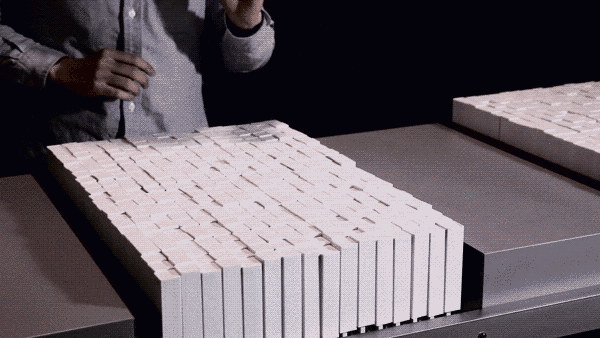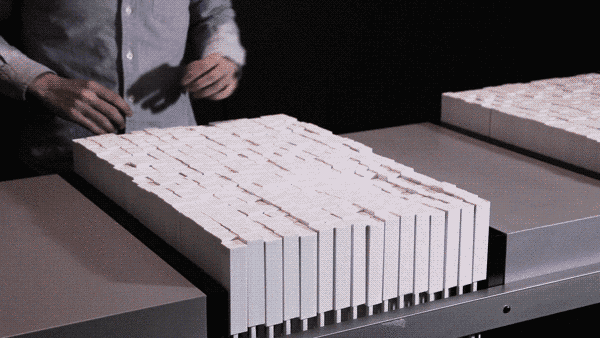For the past few years, the team at MIT Media Lab’s Tangible Media Group has explored the future of digital interfaces with a low-resolution display made of white, plastic pins. It's an unconventional display---the pins, each of which represents a pixel, are bundled together into an unassuming-looking grid---but it’s capable of truly impressive things.
The Tangible Media Group calls its latest project Materiable. It bears a close resemblance to InFORM and Transform, MIT projects in which the pins rendered information in 3-D shapes and reacted to human gestures, respectively. But Materiable's hardware and software have been altered to replicate the characteristics of materials like water, rubber, and clay by mimicking the physical properties of flexibility, elasticity, and viscosity.
Sensors embedded below the pins register how much pressure is applied to each pixel, and actuators within the pins control their response to that pressure. As a result, interacting with the display is a simultaneously visual and tactile experience, eliciting what the researchers call a "pseudo-haptic effect." Simply put: Your brain is more likely to perceive a grid of plastic pins as something else entirely if, when you flick it, it ripples like a pool of water, or, when pressing against it with your palm, it presses back like a slab of rubber.
Using an interface to imitate the real world is not a new idea. As the researchers note in their paper, designers have been simulating real-world properties with GUIs for years. One of the most recent, and compelling, applications of this concept is Material Design, a visual design language that Google built from the ground up, starting with cutouts of actual construction paper. Light, shadows, and movements that obey the laws of physics lend Material Design's elements a three-dimensional, almost-tactile quality that can help users understand how to interact with Google’s products. Our familiarity with material properties is useful, even in the two-dimensional world, because it helps us grok how thing are supposed to work.
Materiable is a three-dimensional extension of similar ideas, and hints at how materiality could be used to build a tangible bridge between our digital and physical interfaces. As platforms like virtual and augmented reality go mainstream, the desire for actual, physical interfaces begin to make more sense. As Luke Vink, one of the lead researchers, explains, the metaphors that work in the digital world won't necessarily translate to the physical world. A menu on a VR platform, for example, feels less natural than simply touching the object you're seeing in your headset. “There’s the computer approach to the way we do things and this physical one,” he says. “When you start to combine those two worlds you start to get in some ways very confused. It’s a very complex problem.”



